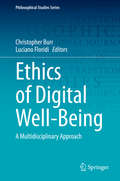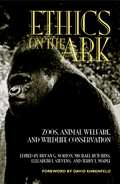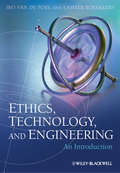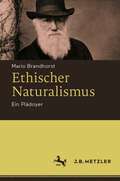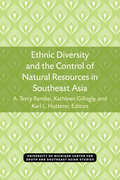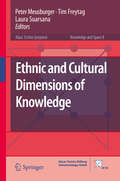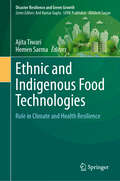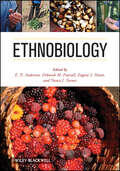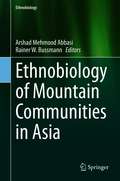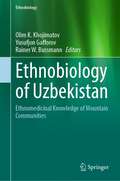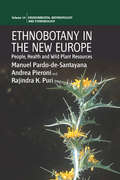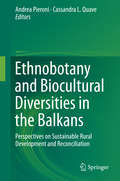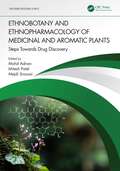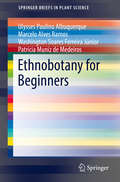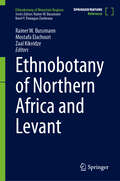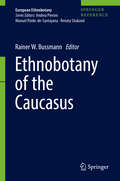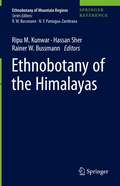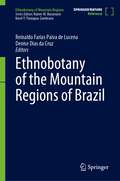- Table View
- List View
Ethics of Digital Well-Being: A Multidisciplinary Approach (Philosophical Studies Series #140)
by Luciano Floridi Christopher BurrThis book brings together international experts from a wide variety of disciplines, in order to understand the impact that digital technologies have had on our well-being as well as our understanding of what it means to live a life that is good for us. The multidisciplinary perspective that this collection offers demonstrates the breadth and importance of these discussions, and represents a pivotal and state-of-the-art contribution to the ongoing discussion concerning digital well-being. Furthermore, this is the first book that captures the complex set of issues that are implicated by the ongoing development of digital technologies, impacting our well-being either directly or indirectly. By helping to clarify some of the most pertinent issues, this collection clarifies the risks and opportunities associated with deploying digital technologies in various social domains.Chapter 2 is available open access under a Creative Commons Attribution 4.0 International License via link.springer.com.
Ethics of the Use of Human Subjects in Research: (Practical Guide)
by Adil Shamoo Felix A. Khin-Maung-GyiMedia headlines about research misconduct in American Universities have focused public attention on the dramatic ethical problems that can arise during the conductof research. In the current atmosphere of accountability, scientific research on humans is now under increased scrutiny by the media, Congress and the public. Ethics of the Use of Human Subjects in Research fills the need for learning materials and strategies providing support for training programs related to the ethics of the use of human subjects in research. It presents a practical introduction to the ethical issues at stake in the conduct of research with human subjects. Beginning with a chapter on research ethics, a total of 10 chapters range in scope from the deveolopment of a protocol for ethical decision making to how to obtain IRB approval, with an emphasis on ethical factors underpinning the IRB process.
Ethics on the Ark: Zoos, Animal Welfare, and Wildlife Conservation
by Terry Maple Elizabeth Stevens Michael Hutchins Bryan G. NortonEthics on the Ark presents a passionate, multivocal discussion--among zoo professionals, activists, conservation biologists, and philosophers--about the future of zoos and aquariums, the treatment of animals in captivity, and the question of whether the individual, the species, or the ecosystem is the most important focus in conservation efforts. Contributors represent all sides of the issues. Moving from the fundamental to the practical, from biodiversity to population regulation, from animal research to captive breeding, Ethics on the Ark represents an important gathering of the many fervent and contentious viewpoints shaping the wildlife conservation debate.From the Trade Paperback edition.
Ethics, Technology, and Engineering: An Introduction
by Ibo van de Poel Lamb¿r RoyakkersFeaturing a wide range of international case studies, Ethics, Technology, and Engineering presents a unique and systematic approach for engineering students to deal with the ethical issues that are increasingly inherent in engineering practice. Utilizes a systematic approach to ethical case analysis -- the ethical cycle -- which features a wide range of real-life international case studies including the Challenger Space Shuttle, the Herald of Free Enterprise and biofuels. Covers a broad range of topics, including ethics in design, risks, responsibility, sustainability, and emerging technologies Can be used in conjunction with the online ethics tool Agora (http://www.ethicsandtechnology.com) Provides engineering students with a clear introduction to the main ethical theories Includes an extensive glossary with key terms
Ethics, Technology, and Engineering: An Introduction
by Lamber Royakkers Ibo van de PoelExplore the moral and ethical issues which arise at the intersection of novel technology and engineering In Ethics, Technology, and Engineering: An Introduction, a team of distinguished researchers delivers an insightful and thought-provoking exploration of some of the toughest ethical questions found at the crossroads of engineering and technology. The book demonstrates the skills necessary to effectively grapple with ethical issues that arise from the practice of engineering. The authors introduce the “ethical cycle,” a unique and systematic approach to dealing with ethical problems. They utilize numerous real-life case studies from the United States, Europe, and elsewhere to shed important light on the ethical issues that arise in the daily work of practicing engineers. They also provide a comprehensive overview of various ethical frameworks used in engineering, including utilitarianism, deontological ethics, virtue ethics, Ubuntu, and Confucianism. Readers will also find: A thorough introduction to a practice-oriented approach to ethical decision-making in engineering Comprehensive explorations of the “ethical cycle,” an approach that encourages students to consider a diversity of ethical viewpoints and come to reasoned and justified judgments Practical discussions of ethical issues in engineering design, technological risks, and moral responsibility Treatments of sustainability and how it affects professionals working in engineering, as well as responsible innovationPerfect for engineers, technologists, and entrepreneurs, Ethics, Technology, and Engineering: An Introduction will also benefit businesspeople and founders interested in the ethical implications of a variety of fascinating new technologies.
Ethik in den Ingenieurwissenschaften: Eine Annäherung
by Dieter D. Genske Uta BreuerDie Ingenieurwissenschaften tragen wesentlich zur Gestaltung unserer Zukunft bei. Umso mehr überrascht es, dass ethische Fragen in ingenieurwissenschaftliche Curricula kaum einfließen. Auch praktizierenden Ingenieurinnen und Ingenieuren bleibt die Thematik zumeist fremd. In dieser Edition wird der ethische Anspruch der Ingenieurwissenschaften historisch aufgearbeitet, neu definiert und an aktuellen Beispielen wie dem Dieselskandal, der Klimakrise, den Suchmaschinen und sozialen Netzwerken, der künstlichen Intelligenz und der Covid19-Pandemie verdeutlicht. Dabei sollen sowohl Studierende als auch Praktizierende der Ingenieurwissenschaften angesprochen werden
Ethik in den Wissenschaften: Einblicke und Ausblicke (Ethik – Mensch - Technik)
by Karen JoistenDas vorliegende Buch gewährt Einblicke und Ausblicke in unterschiedliche Disziplinen der Wissenschaft und die mit ihnen einhergehenden ethischen Probleme und Fragestellungen. Das Buch richtet sich neben dem akademischen Fachpublikum vor allem auch an ein breiteres Publikum, da Ethik nur nachhaltig sein kann, wenn auch die breite Bevölkerung sich kompetent und engagiert ethischen Problemen und Fragen stellt und in den Diskurs einbringt.Die Themen, die in diesem Band diskutiert werden, beziehen sich auf: Ethos und Pathos der Architektur, ethische Aspekte des Regierens, die Digitale Transformation, eine philosophische Unterscheidung von Roboter und Mensch, Grenzen der Medizin, ethische Kriterien der Technikfolgenabschätzung, ethische Entscheidungen im Nachhaltigkeitsmanagement und eine juristische Sicht auf Nachhaltigkeit und Umweltgerechtigkeit.
Ethische Aspekte der medizinischen Altersschätzung bei unbegleiteten minderjährigen Migrantinnen und Migranten
by Marius Leander HuesmannIst das Alter von unbegleiteten minderjährigen Migrantinnen und Migranten bei der Einreise nach Deutschland nicht sicher nachweisbar, kann eine medizinische Altersschätzung angeordnet werden. Diese Dissertation analysiert zum einen, ob die medizinische Altersschätzung geeignet ist, eine Minder- oder Volljährigkeit bei Personen nachzuweisen, die ein Alter von 16 oder 17 Jahren angeben, und zum anderen, wie diese Altersschätzung medizinethisch zu bewerten ist. Hierfür wurden die von der Arbeitsgemeinschaft für Forensische Altersdiagnostik der Deutschen Gesellschaft für Rechtsmedizin derzeit empfohlenen Methoden (körperliche Untersuchung, Röntgenuntersuchung der Hand, der Weisheitszähne, der Schlüsselbeine) auf ihre Aussagekraft hin untersucht. Die Ergebnisse wurden auf Basis der vier medizinethischen Prinzipien von Beauchamp und Childress (Wohltun, Nicht-Schaden, Gerechtigkeit und Respekt vor der Autonomie) diskutiert. Es zeigt sich, dass keine der genannten Untersuchungsmethoden geeignet ist, bei einem angegebenen Alter von 16 oder 17 Jahren sicher eine Minder- oder Volljährigkeit nachzuweisen oder auszuschließen. Zudem sind diese Untersuchungen aus medizinethischer Perspektive in vielerlei Hinsicht problematisch, sodass die medizinische Altersschätzung in der übergroßen Mehrheit der Fälle derzeit aus ethischen Gründen nicht zu rechtfertigen ist.
Ethischer Naturalismus: Ein Plädoyer
by Mario BrandhorstDas Buch entwickelt und verteidigt eine Form des ethischen Naturalismus. Es kreist um zwei Fragen, die durch einen Leitgedanken eng verbunden sind. Dieser Leitgedanke lautet, dass das Leben, das wir führen, mit allen seinen ethischen Aspekten als Teil der Natur anzusehen ist. Die erste Frage lautet, wie dieser Leitgedanke näher zu verstehen ist. Die zweite Frage lautet, was aus diesem Leitgedanken, so verstanden, folgt. Wie könnte das ethische Leben im Verlauf der Evolution des Menschen entstanden sein? Welche Folgen hätte das für uns? Die Untersuchung setzt bei Darwins Grundeinsichten an, die sie durch die weitere Entwicklung der Theorie der Evolution durch natürliche Selektion und moderne Hypothesen zur Erklärung der Entstehung des ethischen Lebens bis zum aktuellen Stand der Diskussion verfolgt. Wie sich zeigt, ist eine naturalistische Deutung nicht nur mit ethischem Denken und Handeln vereinbar, sondern trägt auch dazu bei, dessen Strukturen zu erklären. Relativiert werden dagegen die Ansprüche vieler Moraltheorien, die von überzogenen Erwartungen im Hinblick auf die Objektivität oder die Formalisierbarkeit des Ethischen geleitet sind. Den Abschluss bildet eine Fallstudie zur Menschenwürde, die nach der Deutung dieses Buchs zwar naturalistisch umgedeutet werden muss, aber als eine zentrale ethische Idee erhalten bleiben kann.
Ethnic Diversity and the Control of Natural Resources in Southeast Asia (Michigan Papers On South And Southeast Asia #32)
by Karl L. Hutterer A. Terry Rambo Kathleen GilloglyThe authors consider the ways in which the high degree of ethnic diversity within the region is related to the nature of tropical Asian environments, on the one hand, and the nature of Southeast Asian political systems and the ways in which they manipulate natural resources, on the other. Rather than focus on defining the phenomenon of ethnicity, this book examines the different social evolutionary contexts in which the phenomenon is manifested. Companion volume to Cultural Values and Human Ecology in Southeast Asia (Michigan Papers no. 27).
Ethnic Fermented Foods and Beverages of India: Science History and Culture
by Jyoti Prakash TamangThis book provides detailed information on the various ethnic fermented foods and beverages of India. India is home to a diverse food culture comprising fermented and non-fermented ethnic foods and alcoholic beverages. More than 350 different types of familiar, less-familiar and rare ethnic fermented foods and alcoholic beverages are traditionally prepared by the country’s diverse ethnic groups, and include alcoholic, milk, vegetable, bamboo, legume, meat, fish, and cereal based beverages. Most of the Indian ethnic fermented foods are naturally fermented, whereas the majority of the alcoholic beverages have been prepared using dry starter culture and the ‘back-sloping’ method for the past 6,000 years. A broad range of culturable and unculturable microbiomes and mycobiomes are associated with the fermentation and production of ethnic foods and alcoholic drinks in India. The book begins with detailed chapters on various aspects including food habits, dietary culture, and the history, microbiology and health benefits of fermented Indian food and beverages. Subsequent chapters describe unique and region-specific ethnic fermented foods and beverages from all 28 states and 9 union territories. In turn the classification of various ethnic fermented foods and beverages, their traditional methods of preparation, culinary practices and mode of consumption, socio-economy, ethnic values, microbiology, food safety, nutritional value, and process optimization in some foods are discussed in details with original pictures. In closing, the book addresses the medicinal properties of the fermented food products and their health benefits, together with corresponding safety regulations.
Ethnic and Cultural Dimensions of Knowledge
by Peter Meusburger Laura Suarsana Tim FreytagThis book presents theoretical and methodical discussions on local knowledge and indigenous knowledge. It examines educational attainment of ethnic minorities, race and politics in educational systems, and the problem of losing indigenous knowledge. It comprises a broad range of case studies about specifics of local knowledge from several regions of the world, reflecting the interdependence of norms, tradition, ethnic and cultural identities, and knowledge. The contributors explore gaps between knowledge and agency, address questions of the social distribution of knowledge, consider its relation to communal activities, and inquire into the relation and intersection of knowledge assemblages at local, national, and global scales. The book highlights the relevance of local and indigenous knowledge and discusses implications for educational and developmental politics. It provides ideas and a cross-disciplinary scientific background for scholars, students, and professionals including NGO activists, and policy-makers.
Ethnic and Indigenous Food Technologies: Role in Climate and Health Resilience (Disaster Resilience and Green Growth)
by Hemen Sarma Ajita TiwariIndigenous fermented foods have long served as essential components of traditional diets across the world. These include both fermented and non-fermented varieties, often rooted in centuries-old practices of food preparation and preservation. Beyond extending shelf life, fermentation enhances the physiochemical properties and nutritional profile of food. However, with the increasing impacts of climate change, globalization, urbanization, and the rising availability of processed fast foods, many indigenous food cultures are rapidly declining. This book explores the intersection of ethnic fermented foods, global ecological change, and evolving fermentation technologies. It examines how climate variability affects traditional food systems and emphasizes the need for preserving indigenous knowledge. The volume provides in-depth insights into the biochemistry, microbiology, biotechnology, and nutritional composition of a diverse range of ethnic and indigenous fermented foods. With a focus on both traditional practices and contemporary scientific advancements, this book offers valuable perspectives on sustainable food systems, food security, and health resilience. It serves as a vital reference for researchers, academicians, and students in the fields of food science, biotechnology, microbiology, biochemistry, and environmental studies.
Ethnobiology
by E. N. Anderson D. Pearsall E. Hunn N. TurnerThe single comprehensive treatment of the field, from the leading members of the Society of Ethnobiology The field of ethnobiology—the study of relationships between particular ethnic groups and their native plants and animals—has grown very rapidly in recent years, spawning numerous subfields. Ethnobiological research has produced a wide range of medicines, natural products, and new crops, as well as striking insights into human cognition, language, and environmental management behavior from prehistory to the present. This is the single authoritative source on ethnobiology, covering all aspects of the field as it is currently defined. Featuring contributions from experienced scholars and sanctioned by the Society of Ethnobiology, this concise, readable volume provides extensive coverage of ethical issues and practices as well as archaeological, ethnological, and linguistic approaches. Emphasizing basic principles and methodology, this unique textbook offers a balanced treatment of all the major subfields within ethnobiology, allowing students to begin guided research in any related area—from archaeoethnozoology to ethnomycology to agroecology. Each chapter includes a basic introduction to each topic, is written by a leading specialist in the specific area addressed, and comes with a full bibliography citing major works in the area. All chapters cover recent research, and many are new in approach; most chapters present unpublished or very recently published new research. Featured are clear, distinctive treatments of areas such as ethnozoology, linguistic ethnobiology, traditional education, ethnoecology, and indigenous perspectives. Methodology and ethical action are also covered up to current practice. Ethnobiology is a specialized textbook for advanced undergraduates and graduate students; it is suitable for advanced-level ethnobotany, ethnobiology, cultural and political ecology, and archaeologically related courses. Research institutes will also find this work valuable, as will any reader with an interest in ethnobiological fields.
Ethnobiology of Mountain Communities in Asia (Ethnobiology)
by Arshad Mehmood Abbasi Rainer W. BussmannNatural resources and associated biological diversity provide the basis of livelihood for human population, particularly in the rural areas and mountain regions across the globe. Asia is home to the world's highest mountain regions including the Himalayas, Karakorum and Hindukush. These regions are renowned around the globe because of their unique beauty, climate, and biocultural diversity. Because of geoclimatic conditions, the mountains of Asia are medicinal and food plant diversity hot spots. The indigenous communities residing in the valleys of these mountains have their own culture and traditions, and have a long history of interaction with the surrounding plant diversity. Local inhabitants of these mountains areas possess significant traditional knowledge of plant species used as food, medicine, and for cultural purposes. So far, many workers have reported traditional uses of plant species from different regions of Asia including some mountain areas; however, there is not one inclusive document on the ethnobotany of mountains in Asia. This book provides a comprehensive overview on ethno-ecological knowledge and cross cultural variation in the application of plant species among various communities residing in the mountains of Asia; cross cultural variation in traditional uses of plant species by the mountain communities; high value medicinal and food plant species; and threats and conservation status of plant species and traditional knowledge. This book should be useful to researchers of biodiversity and conservation, ethnobiologists, ethnoecologists, naturalists, phytochemists, pharmacists, policy makers, and all who have a devotion to nature.
Ethnobiology of Uzbekistan: Ethnomedicinal Knowledge of Mountain Communities (Ethnobiology)
by Rainer W. Bussmann Olim K. Khojimatov Yusufjon GafforovNatural resources and associated biological diversity provide the basis of livelihood for humans, particularly in rural areas and mountain regions around the world. Over centuries, indigenous peoples, traditional societies and local communities have developed their own specific knowledge regarding plant use, management, and conservation. The history of plant use by humans as food and to treat diverse ailments dates back to ancient civilizations. Even though the advent of allopathic medicine has somehow minimized the role of medicinal plants in favor of synthetic drugs, a number of modern drug discoveries have been based on medicinal plants used by indigenous peoples. Ethnobiology is the burgeoning interdisciplinary scientific field which covers all sorts of interactions between plants and people, and Central Asia is recognized as a plant diversity hot spot. The mountains and valleys of this region are rich in unique medicinal and food plant species. Local communities residing in the mountain regions of Central Asia possess unique knowledge of surrounding resources, which is the result of many years of interaction with and selection of the most desirable and pervasive plant species present. In this context, this book provides comprehensive information on cross-culture variation in the traditional uses of plants, fungi, and animal species as food, medicine, and for cultural purposes among the diverse communities of Uzbekistan. The key areas of focus include plant diversity in Uzbekistan, cross cultural variation in traditional uses of plant species, high-value medicinal and food plant species, and threats and conservation status of plant species and traditional knowledge
Ethnobotany In The New Europe: People, Health and Wild Plant Resources (Environmental Anthropology and Ethnobiology #14)
by Andrea Pieroni Manuel Pardo-de-Santayana Rajindra K. PuriThe study of European wild food plants and herbal medicines is an old discipline that has been invigorated by a new generation of researchers pursuing ethnobotanical studies in fresh contexts. Modern botanical and medical science itself was built on studies of Medieval Europeans' use of food plants and medicinal herbs. In spite of monumental changes introduced in the Age of Discovery and Mercantile Capitalism, some communities, often of immigrants in foreign lands, continue to hold on to old recipes and traditions, while others have adopted and enculturated exotic plants and remedies into their diets and pharmacopoeia in new and creative ways. Now in the 21st century, in the age of the European Union and Globalization, European folk botany is once again dynamically responding to changing cultural, economic, and political contexts. The authors and studies presented in this book reflect work being conducted across Europe's many regions. They tell the story of the on-going evolution of human-plant relations in one of the most bioculturally dynamic places on the planet, and explore new approaches that link the re-evaluation of plant-based cultural heritage with the conservation and use of biocultural diversity.
Ethnobotany and Biocultural Diversities in the Balkans
by Andrea Pieroni Cassandra L. QuaveThis volume addresses recent and ongoing ethnobotanical studies in the Balkans. The book focuses on elaborating the relevance of such studies for future initiatives in this region, both in terms of sustainable and peaceful (trans-regional, trans-cultural) rural development. A multi-disciplinary viewpoint is utilized, with an incorporation of historical, ethnographic, linguistic, biological, nutritional and medical perspectives. The book is also authored by recognized scholars, who in the last decade have extensively researched the Balkan traditional knowledge systems as they pertain to perceptions of the natural world and especially plants. Ethnobotany and Biocultural Diversities in the Balkans is the first ethnobotany book on one of the most biologically and culturally diverse regions of the world and is a valuable resource for both scholars and students interested in the field of ethnobotany.
Ethnobotany and Ethnopharmacology of Medicinal and Aromatic Plants: Steps Towards Drug Discovery (Exploring Medicinal Plants)
by Mohd Adnan Mitesh Patel Mejdi SnoussiMedicinal and aromatic plants are beneficial to human health. Plant-derived molecules possess biological activities that can be used to prevent many infectious diseases and metabolic disorders. Ethnobotany and Ethnopharmacology of Medicinal and Aromatic Plants summarizes techniques and methods used to study the biological activities of plant-derived extracts and compounds to study ethnobotanical and ethnopharmacological features of medicinal and aromatic plants. This book: Includes computational approaches to study the pharmacological properties of biomolecules in medicinal and aromatic plants. Details methods in ethnopharmacology including chromatographical and analytical techniques. Demonstrates trends in sustainable use and management of medicinal and aromatic plants. Features information on databases and tools used in computational phytochemistry for drug designing and discovery. Elucidates the importance of phytochemicals as immunomodulators in herbal drug development including their nanoformulations. A volume in the Exploring Medicinal Plants series, Ethnobotany and Ethnopharmacology of Medicinal and Aromatic Plants will be of interest to those working with plant extracts, including botanists and ethnobotanists, pharmacologists and ethnopharmacologists, as well as scientists and researchers interested in natural compounds and their potential applications.
Ethnobotany for Beginners
by Ulysses Paulino Albuquerque Patrícia Muniz De Medeiros Marcelo Alves Ramos Washington Soares Ferreira JúniorDesigned for new scholars, this book features a quick and easy-to-read discussion of ethnobotany along with its major developments. The language is clear and concise, objective and straightforward, and structured to lead the reader from the beginning of this science to the most recent developments. While there are some books on ethnobotany, mainly dealing with methods, this book covers the topic in an introductory and comprehensive text that prepares the reader for more advanced study of ethnobotany.
Ethnobotany of Mexico
by Alejandro Casas Rafael Lira José BlancasThis book reviews the history, current state of knowledge, and different research approaches and techniques of studies on interactions between humans and plants in an important area of agriculture and ongoing plant domestication: Mesoamerica. Leading scholars and key research groups in Mexico discuss essential topics as well as contributions from international research groups that have conducted studies on ethnobotany and domestication of plants in the region. Such a convocation will produce an interesting discussion about future investigation and conservation of regional human cultures, genetic resources, and cultural and ecological processes that are critical for global sustainability.
Ethnobotany of Northern Africa and Levant (Ethnobotany of Mountain Regions)
by Rainer W. Bussmann Zaal Kikvidze Mostafa ElachouriResearch in recent years has increasingly shifted away from purely academic research, and into applied aspects of the discipline, including climate change research, conservation, and sustainable development. It has by now widely been recognized that “traditional” knowledge is always in flux and adapting to a quickly changing environment. Trends of globalization, especially the globalization of plant markets, have greatly influenced how plant resources are managed nowadays. While ethnobotanical studies are now available from many regions of the world, no comprehensive encyclopedic series focusing on the worlds mountain regions is available in the market. Scholars in plant sciences worldwide will be interested in this dynamic content. The field (and thus the market) of ethnobotany and ethnopharmacology has grown considerably in recent years. Student interest is on the rise, attendance at professional conferences has grown steadily, and the number of professionals calling themselves ethnobotanists has increased significantly. Various societies of such professionals include the Society for Economic Botany, the International Society of Ethnopharmacology, the Society of Ethnobiology, the International Society for Ethnobiology, and many regional and national societies in the field that currently have thousands of members. Growth has been most robust in BRIC countries.The objective of this new MRW on Ethnobotany of Mountain Regions is to take advantage of the increasing international interest and scholarship in the field of mountain research. We anticipate including the best and latest research on a full range of descriptive, methodological, theoretical, and applied research on the most important plants for each region. Each contribution will be scientifically rigorous and contribute to the overall field of study.
Ethnobotany of the Caucasus
by Rainer W. BussmannThe Caucasus MRW (online and print) Volume will cover this European Macroregion. The content will focus on the ethnobotany of wild plants in this Macroregion and it will be first developed as an online site and, later, when all of the planned topics have been covered for this specific volume, printed in a hard copy version. The online site will remain live and be available for updates (with new monographs [if not covered initially due to lack of research]). The content will be divided into sections covering countries (or groups of countries), based on plant diversity and not necessarily political or national boundaries. The Caucasus volume will have an Introduction (4,000-6,000 words); 50 200 plant monographs (10 to maximum 50 monographs per country) with each monograph having a length of ~1,500 words (with references), plus 2-4 photographs. To further define the content, the plant monographs will be divided into five major categories (food; medicine/cosmetic; veterinary; handicraft plants; and ritual/folkloric uses) and include notes. The number of the monographs in every category will be negotiated depending on the advances of the ethnobotanical research in each specific country, or group of countries. The main criteria for the inclusion of a given plant will be its cultural salience within a given country (assessed by the Volume Editor). References will be given at the end of the Introduction and each monograph.
Ethnobotany of the Himalayas (Ethnobotany of Mountain Regions)
by Rainer W. Bussmann Ripu M. Kunwar Hassan SherResearch in recent years has increasingly shifted away from purely academic research, and into applied aspects of the discipline, including climate change research, conservation, and sustainable development. It has by now widely been recognized that “traditional” knowledge is always in flux and adapting to a quickly changing environment. Trends of globalization, especially the globalization of plant markets, have greatly influenced how plant resources are managed nowadays. While ethnobotanical studies are now available from many regions of the world, no comprehensive encyclopedic series focusing on the worlds mountain regions is available in the market. Scholars in plant sciences worldwide will be interested in this website and its dynamic content.The field (and thus the market) of ethnobotany and ethnopharmacology has grown considerably in recent years. Student interest is on the rise, attendance at professional conferences has grown steadily, and the number of professionals calling themselves ethnobotanists has increased significantly (the various societies, like the Society for Economic Botany, the International Society of Ethnopharmacology, the Society of Ethnobiology, and the International Society for Ethnobiology currently have thousands of members). Growth has been most robust in BRIC countries.This new MRW on Ethnobotany of the Himalayas takes advantage of the increasing international interest and scholarship in the field of mountain research. It includes the best and latest research on a full range of descriptive, methodological, theoretical, and applied research on the most important plants in the Himalayas. Each contribution is scientifically rigorous and contributes to the overall field of study.
Ethnobotany of the Mountain Regions of Brazil (Ethnobotany of Mountain Regions)
by Reinaldo Farias Paiva de Lucena Denise Dias da CruzResearch in recent years has increasingly shifted away from purely academic research, and into applied aspects of the discipline, including climate change research, conservation, and sustainable development. It has by now widely been recognized that “traditional” knowledge is always in flux and adapting to a quickly changing environment. Trends of globalization, especially the globalization of plant markets, have greatly influenced how plant resources are managed nowadays. While ethnobotanical studies are now available from many regions of the world, no comprehensive encyclopedic series focusing on the worlds mountain regions is available in the market. Scholars in plant sciences worldwide will be interested in this website and its dynamic content. The field (and thus the market) of ethnobotany and ethnopharmacology has grown considerably in recent years. Student interest is on the rise, attendance at professional conferences has grown steadily, and the number of professionals calling themselves ethnobotanists has increased significantly (the various societies (Society for Economic Botany, International Society of Ethnopharmacology, Society of Ethnobiology, International Society for Ethnobiology, and many regional and national societies in the field currently have thousands of members). Growth has been most robust in BRIC countries.The objective of this new MRW on Ethnobotany of Mountain Regions is to take advantage of the increasing international interest and scholarship in the field of mountain research. We anticipate including the best and latest research on a full range of descriptive, methodological, theoretical, and applied research on the most important plants for each region. Each contribution will be scientifically rigorous and contribute to the overall field of study.
